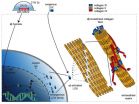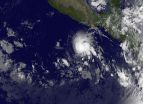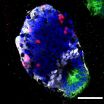(Press-News.org) Lab-grown tissues could one day provide new treatments for injuries and damage to the joints, including articular cartilage, tendons and ligaments.
Cartilage, for example, is a hard material that caps the ends of bones and allows joints to work smoothly. UC Davis biomedical engineers, exploring ways to toughen up engineered cartilage and keep natural tissues strong outside the body, report new developments this week in the journal Proceedings of the National Academy of Sciences.
"The problem with engineered tissue is that the mechanical properties are far from those of native tissue," said Eleftherios Makris, a postdoctoral researcher at the UC Davis Department of Biomedical Engineering and first author on the paper. Makris is working under the supervision of Professor Kyriacos A. Athanasiou, a distinguished professor of biomedical engineering and orthopedic surgery, and chair of the Department of Biomedical Engineering.
While engineered cartilage has yet to be tested or approved for use in humans, a current method for treating serious joint problems is with transplants of native cartilage. But it is well known that this method is not sufficient as a long-term clinical solution, Makris said.
The major component of cartilage is a protein called collagen, which also provides strength and flexibility to the majority of our tissues, including ligaments, tendons, skin and bones. Collagen is produced by the cells and made up of long fibers that can be cross-linked together.
Engineering new cartilage
Researchers in the Athanasiou group have been maintaining native cartilage in the lab and culturing cartilage cells, or chondrocytes, to produce engineered cartilage.
"In engineered tissues the cells produce initially an immature matrix, and the maturation process makes it tougher," Makris said.
Knee joints are normally low in oxygen, so the researchers looked at the effect of depriving native or engineered cartilage of oxygen. In both cases, low oxygen led to more cross-linking and stronger material. They also found that an enzyme called lysyl oxidase, which is triggered by low oxygen levels, promoted cross-linking and made the material stronger.
"The ramifications of the work presented in the PNAS paper are tremendous with respect to tissue grafts used in surgery, as well as new tissues fabricated using the principles of tissue engineering," Athanasiou said. Grafts such as cadaveric cartilage, tendons or ligaments — notorious for losing their mechanical characteristics in storage — can now be treated with the processes developed at UC Davis to make them stronger and fully functional, he said.
Athanasiou also envisions that many tissue engineering methods will now be altered to take advantage of this strengthening technique.
INFORMATION:
Other authors on the paper are Donald Responte, Nikolaos Paschos and Jerry Hu, all at the Department of Biomedical Engineering. Funding was provided by the National Institutes of Health.
Making lab-grown tissues stronger
2014-10-30
ELSE PRESS RELEASES FROM THIS DATE:
Experts recommend tumor removal as first-line treatment for acromegaly
2014-10-30
Washington, DC—The Endocrine Society today issued a Clinical Practice Guideline (CPG) for the diagnosis and treatment of acromegaly, a rare condition caused by excess growth hormone in the blood.
The CPG, entitled "Acromegaly: An Endocrine Society Clinical Practice Guideline," appeared in the November 2014 issue of the Journal of Clinical Endocrinology and Metabolism (JCEM), a publication of the Endocrine Society.
Acromegaly is usually caused by a non-cancerous tumor in the pituitary gland. The tumor manufactures too much growth hormone and spurs the body to overproduce ...
Sustained local control for medically inoperable, early stage lung cancer patients
2014-10-30
Chicago, October 30, 2014—Analysis of data from an institutional patient registry on stereotactic body radiotherapy (SBRT) indicates excellent long-term, local control, 79 percent of tumors, for medically inoperable, early stage lung cancer patients treated with SBRT from 2003 to 2012, according to research presented today at the 2014 Chicago Multidisciplinary Symposium in Thoracic Oncology. The Symposium is sponsored by the American Society of Clinical Oncology (ASCO), the American Society for Radiation Oncology (ASTRO), the International Association for the Study ...
What do American babies eat? A lot depends on Mom's socioeconomic background
2014-10-30
BUFFALO, N.Y. – You have to be at least 2 years old to be covered by U.S. dietary guidelines. For younger babies, no official U.S. guidance exists other than the general recommendation by national and international organizations that mothers exclusively breastfeed for at least the first six months.
So what do American babies eat?
That's the question that motivated researchers at the University at Buffalo School of Medicine and Biomedical Sciences to study the eating patterns of American infants at 6 months and 12 months old, critical ages for the development of ...
Twenty-first Eastern Pacific tropical depression born on Oct. 30
2014-10-30
NOAA's GOES-West satellite captured an image of the birth of the Eastern Pacific Ocean's twenty-first tropical depression, located far south of Acapulco, Mexico.
NOAA's GOES-West satellite gathered infrared data on newborn Tropical Depression 21E (TD 21E) and that data was made into an image by NASA/NOAA's GOES Project at NASA's Goddard Space Flight Center in Greenbelt, Maryland. At 1200 UTC (9 a.m. EDT), the GOES-West image showed that thunderstorms circled the low-level center and extended northeast of the center indicating that southwesterly wind shear was affecting ...
Reconstruction of a patterned piece of spinal cord in 3-D culture
2014-10-30
Professor Elly Tanaka and her research group at the DFG Research Center for Regenerative Therapies Dresden - Cluster of Excellence at the TU Dresden (CRTD) demonstrated for the first time the in vitro growth of a piece of spinal cord in three dimensions from mouse embryonic stem cells. Correct spatial organization of motor neurons, interneurons and dorsal interneurons along the dorsal/ventral axis was observed.
This study has been published online by the American journal "Stem Cell Reports" on 30.10.2014.
For many years Elly Tanaka and her research group have been studying ...
Harnessing error-prone chips
2014-10-30
As transistors get smaller, they also grow less reliable. Increasing their operating voltage can help, but that means a corresponding increase in power consumption.
With information technology consuming a steadily growing fraction of the world's energy supplies, some researchers and hardware manufacturers are exploring the possibility of simply letting chips botch the occasional computation. In many popular applications — video rendering, for instance — users probably wouldn't notice the difference, and it could significantly improve energy efficiency.
At ...
Female frogs modify offspring development depending on reproduction date
2014-10-30
Global warming is altering the reproduction of plants and animals, notably accelerating the date when reproduction and other life processes occur. A study by the University of Uppsala (Sweden), including the participation of Spanish researcher Germán Orizaola, has discovered that some amphibians are capable of making their offspring grow at a faster rate if they have been born later due to the climate.
Over recent decades many organisms, both plants and animals, have experienced a notable advance in the date when many of their life processes (like reproduction, migration ...
Could daylight savings time be a risk to diabetics?
2014-10-30
Soon, many will turn back the hands of time as part of the twice-annual ritual of daylight savings time. That means remembering to change the alarm clock next to the bed, which will mean an extra hour of sleep before getting up in the morning.
But for some diabetics who use insulin pumps, Saleh Aldasouqi, associate professor of medicine at Michigan State University, suggests that remembering to change the time on this device should be the priority.
"Some diabetes patients who use insulin pumps may forget to change the clock that is found in these devices," said diabetes ...
Is space tourism safe or do civilians risk health effects?
2014-10-30
Rochelle, NY, October 30, 2014—Several companies are developing spacecraft designed to take ordinary citizens, not astronauts, on short trips into space. "Space tourism" and short periods of weightlessness appear to be safe for most individuals according to a series of articles on space biomedicine published in New Space, a peer-reviewed journal from Mary Ann Liebert, Inc., publishers. The articles are available free on the New Space website until November 30, 2014.
James Vanderploeg, MD, MPH and colleagues, University of Texas Medical Branch, Galveston, coauthored ...
NASA sees Cyclone Nilofar looking more like a comet than a tropical cyclone
2014-10-30
Tropical Cyclone Nilofar was closing in on the border between Pakistan and northwestern India on Oct. 30 when NASA's Terra satellite passed overhead from space. Wind shear continued to affect the storm making it appear more like a comet with a tail, than a tropical cyclone.
The MODIS or Moderate Resolution Imaging Spectroradiometer instrument that flies aboard NASA's Terra satellite captured a visible image of Nilofar on Oct. 30 at 06:35 UTC (2:35 a.m. EDT). Nilofar was still being affected by southwesterly wind shear, which was blowing the clouds and showers to the northeast. ...







